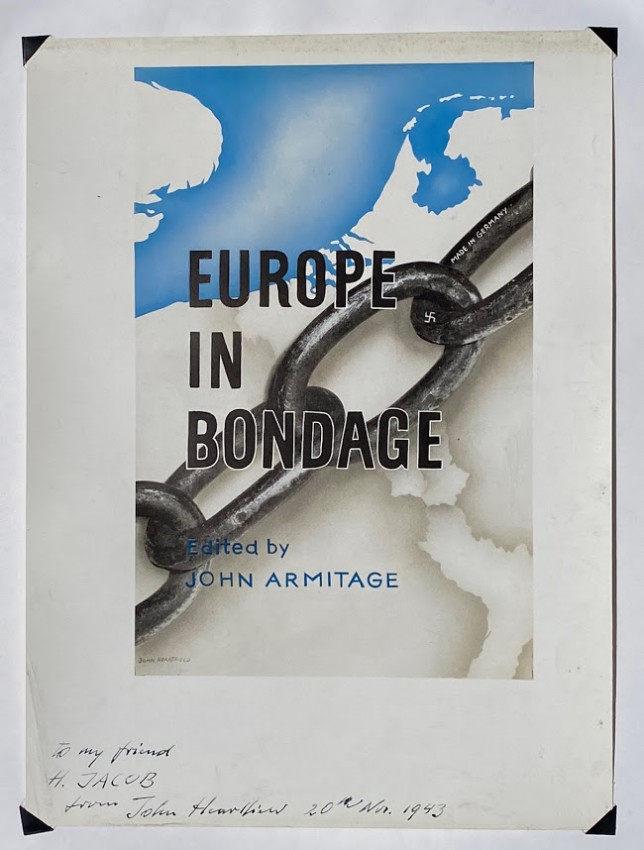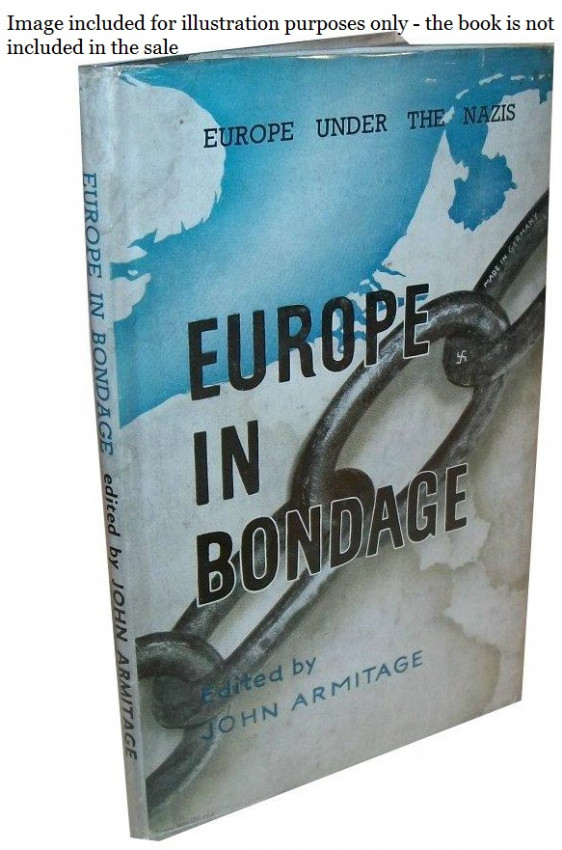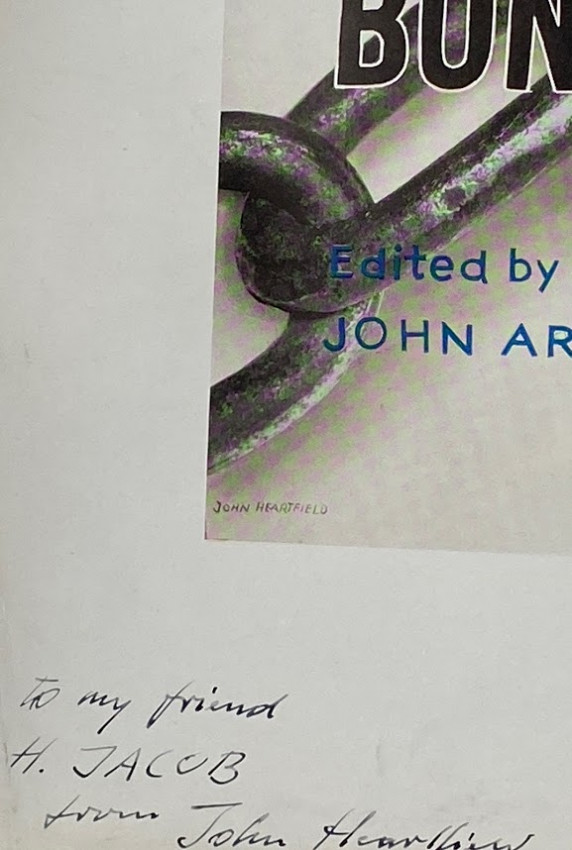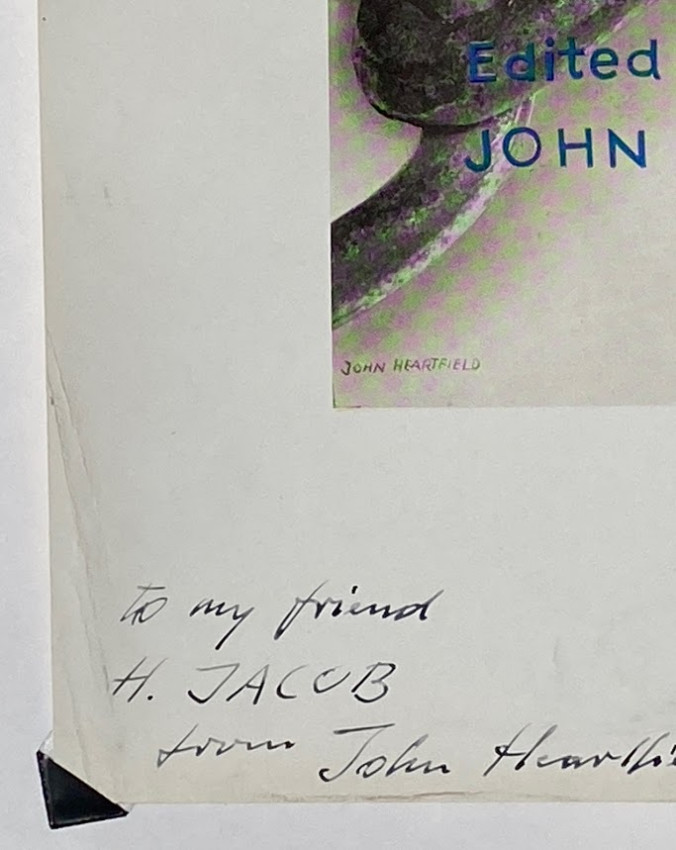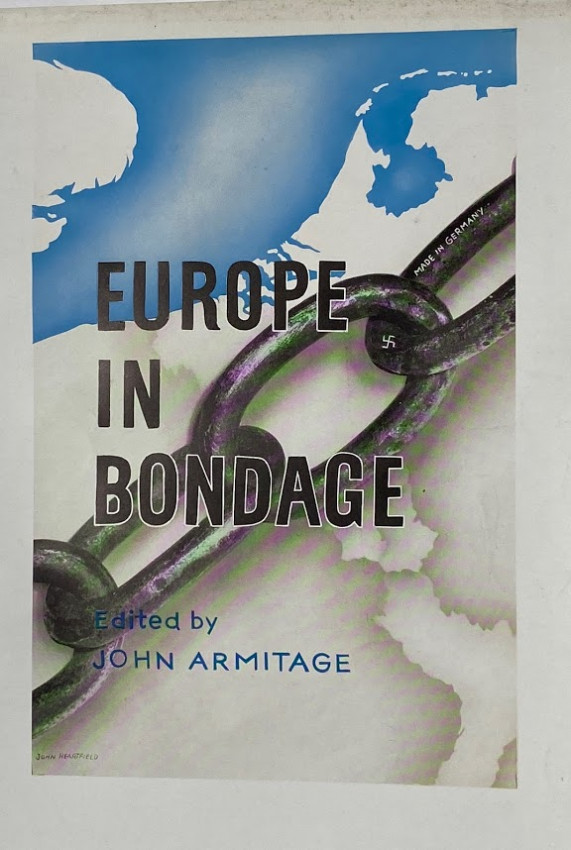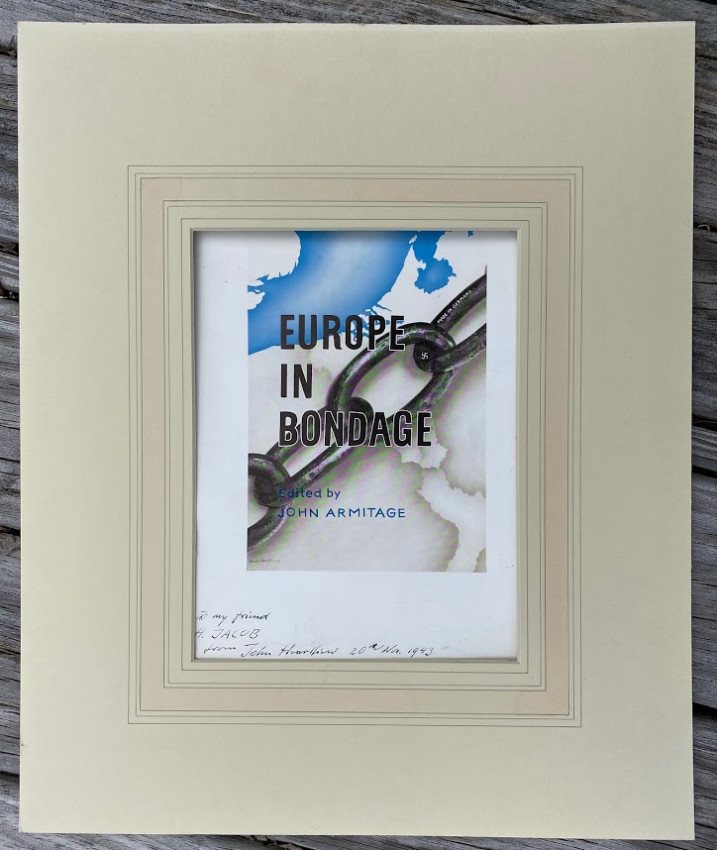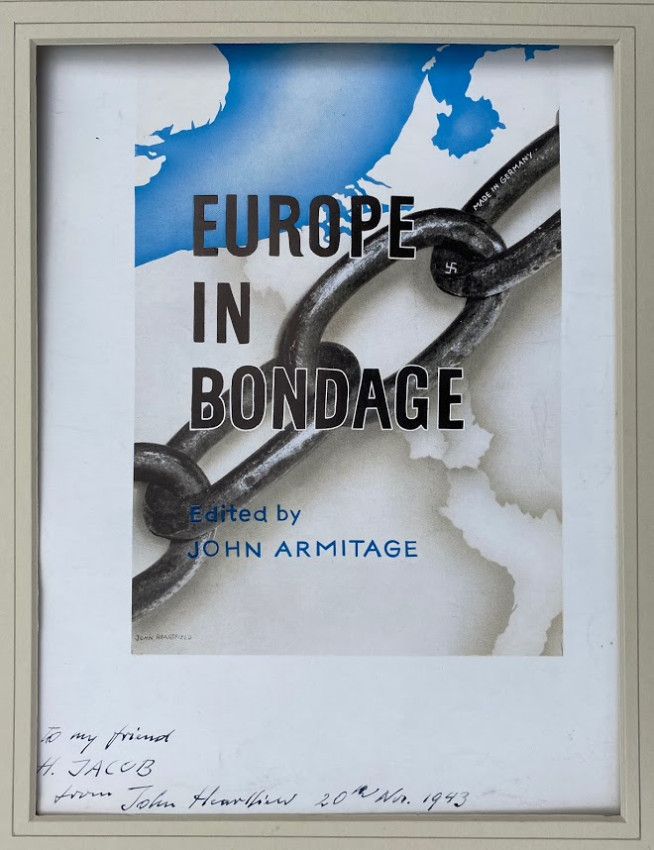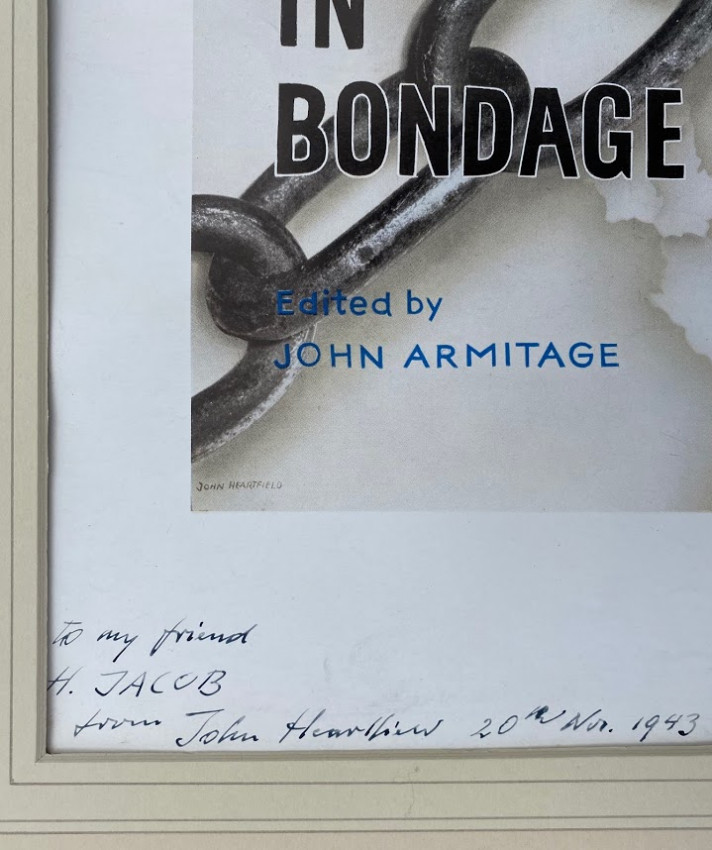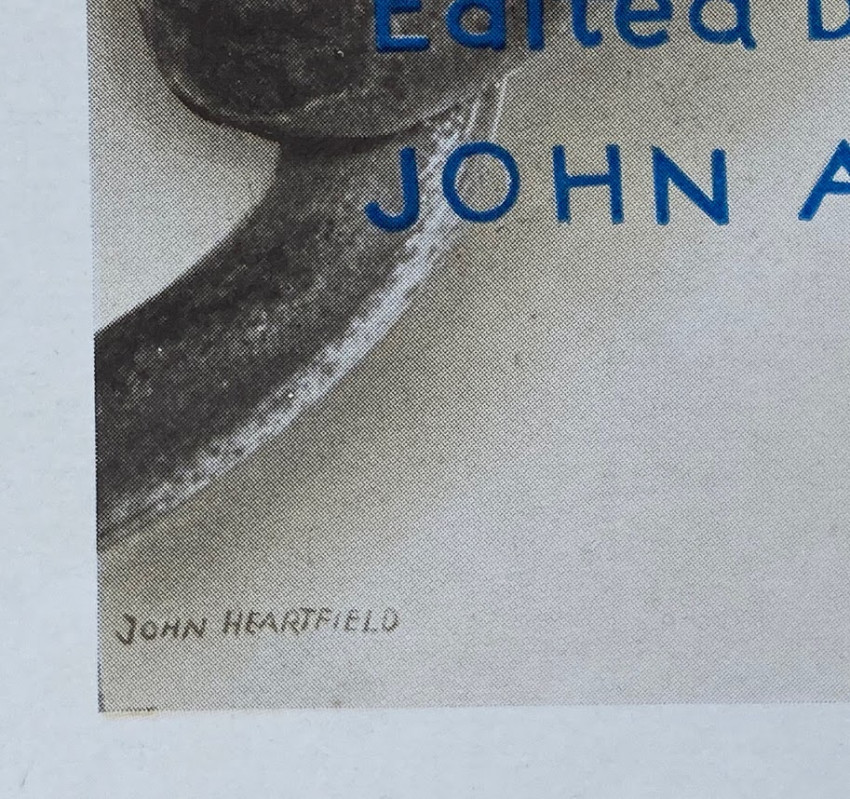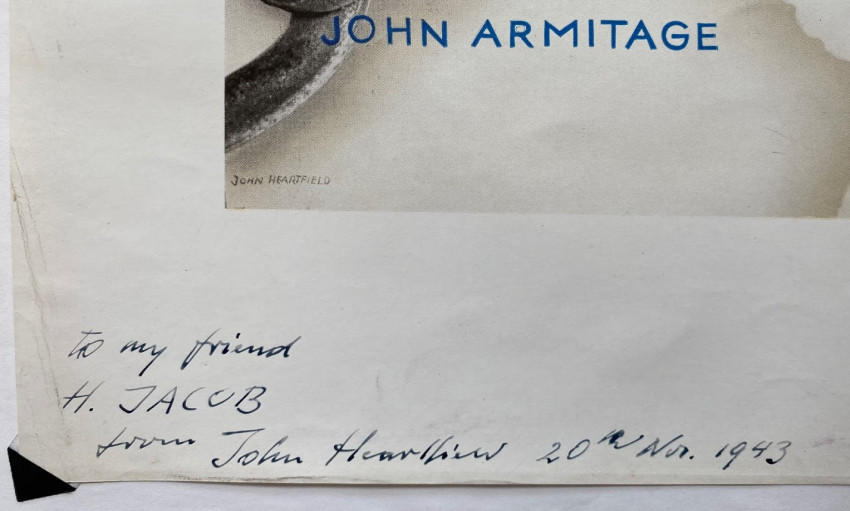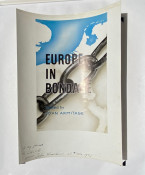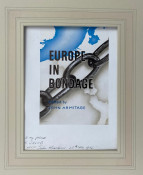John HEARTFIELD (1891-1968, designer).
An inscribed progress proof of Heartfield’s design for the upper cover of the dust-jacket of ‘Europe in Bondage Edited by John Armitage’ [London: Nov. 1943 or earlier]. Colored proof on coated paper (sheet size: 11 3/8 x 8 3/8in; 288 x 213mm), signed in the plate ‘John Heartfield’, the lower left corner of the sheet inscribed in blue ink ‘To my friend / H. Jacob / from John Heartfield 20th Nov. 1943’.
Condition: light discoloration and creasing.
A powerful image from an important figure in the European ‘avant-garde’: John Heartfield aka ‘Monteurdada.’
“Biography from National Gallery of Art, Washington DC … John Heartfield was born on June 19, 1891, as Helmut Franz Josef Herzfeld in Berlin-Schmargendorf. He was the first son of the socialist writer Franz Herzfeld, who wrote under the pseudonym Franz Held, and Alice Herzfeld, née Stolzenberg, a textile worker and political activist. In 1895, convicted of blasphemy and fleeing a prison sentence, Franz Herzfeld and family eventually took up residence in an abandoned hut in the woods in Aigen, near Salzburg, Austria. One day in 1899, the four Herzfeld children woke up to find their parents missing. The mayor of Aigen took the children into his foster care, a situation that proved extremely difficult for the young, quick-tempered Helmut.
In 1905, after having finished school, Herzfeld began an apprenticeship in a bookshop in Wiesbaden, Germany. Three years later, in 1908, Herzfeld went to study at the Royal Bavarian School of Applied Arts in Munich, which at the time was Germany's center of art. Herzfeld's role models were influenced by art nouveau commercial design, including work by Albert Weisgerber, Ludwig Hohlwein, and Koloman Moser, thus nourishing Herzfeld's inclination toward a functional art for a mass audience.
In 1912 he worked as packaging designer in a printing company in Mannheim. He also designed his first book jacket, for the selected works of his father. In 1913 Herzfeld moved to Berlin, where he continued his art education at the Arts and Crafts School in Berlin-Charlottenburg, under Ernst Neumann. In 1914, the same year that Herzfeld won first prize in the Werkbund Exhibit in Cologne for the design of a wall mural, he was conscripted into military service in World War I. Herzfeld served as a guard in Berlin for most of 1915, until he provoked a discharge by simulating mental illness. In his subsequent civil service as a postal carrier in Berlin-Grunewald, Herzfeld tossed the mail into a gully as an act of antiwar sabotage, in the hopes that the inhabitants of this wealthy suburb would get angry at the unsatisfactory conditions on the home front.
In 1916, in the midst of the war, Helmut Herzfeld anglicized his name to "John Heartfield," a protest against the anglophobia that took hold of Germany shortly after the English entered the war on August 4, 1914. "God Punish England!" rang a popular street greeting. (Georg Gross changed his name to George Grosz in the same year.) In July 1916, Wieland Herzfelde and John Heartfield published the journal Neue Jugend (New Youth), a vehicle for antiwar and pacifist views. In 1917 Heartfield helped his brother establish the Malik Verlag publishing group and oversaw all typographical projects. During this time, he also worked as a film set designer for the Grünbaum brothers and produced propaganda films and later animated films in collaboration with George Grosz in the Military Educational Film Service (later renamed UFA).
Heartfield, his brother, Grosz, and Erwin Piscator signed up with the fledgling German Communist Party at, or just after, the First Party Congress, December 30, 1918-January 1, 1919. In Heartfield's involvement with Berlin Dada, he was known as Monteurdada, not only because his preferred artistic medium was photomontage, but also because he took to wearing blue overalls (a Monteuranzug in German) in alliance with the industrial laborer. In German, the connection of montage to industrial assembly-line production is linguistically explicit, for montieren means "to assemble" while a Monteur is a mechanic or engineer.
Heartfield was dismissed from his position at UFA in 1919 because he called for a strike after the murders of Karl Liebknecht and Rosa Luxemburg. He co-edited the satirical periodical Jedermann sein eigner Fussball (Everyone His Own Soccer Ball), which was banned after the first edition because of its inflammatory content. Together with Herzfelde and Grosz, Heartfield founded the satirical political magazine Die Pleite (Bankruptcy), a combination of socially critical reportage and caricature (usually the hand of Grosz). In 1919 Heartfield also befriended Otto Dix. In April 1920 Heartfield and Grosz published an article called "Der Kunstlump" (Art Rogue) in Der Gegner (The Opponent), which triggered heated discussions about the roles of fine art and proletarian art. Heartfield helped organize the First International Dada Fair with Grosz and Raoul Hausmann that opened on July 1, 1920, for which Heartfield designed a four-page catalogue.
After his involvement with Berlin Dada, Heartfield designed book jackets, typography, and layouts for left-wing publishers and worked for the German Communist Party as an editor and designer. In 1930 he began to produce political photomontages regularly for the popular pro-communist journal Arbeiter Illustrierte Zeitung (Workers' Illustrated Journal), generating his anti-Nazi montages in exile in Prague after 1933. When the Nazis invaded Czechoslovakia in 1938, Heartfield fled to England. He joined his brother in the German Democratic Republic in 1951.
John Heartfield died on April 26, 1968 in Berlin, East Germany.”
- Sold By: Shadowrock Rare Books
- Contact Person: Adam Langlands
- Country: United States
- Email: [email protected]
- Telephone: 001-860-248-1547
- Preferred Payment Methods: Paypal, US$ checks and wire transfers, major credit cards through paypal
- Trade Associations: AA Approved


